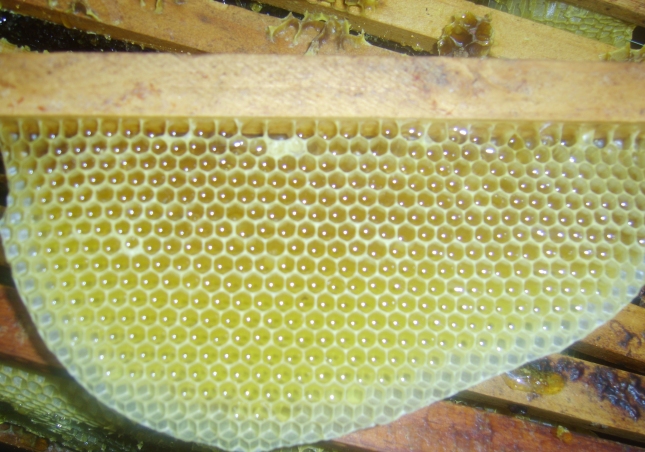Background
For hundreds of years, people knew of the benefits of honey as a wound dressing. Enter modern medicine and the belief is that if it doesn’t come in a commercial tube, it’s no good. But of late, there has been a definite and exciting shift back towards the natural and impressive results achieved by an easily and readily available product.
The benefits observed in the clinical application of unpasteurised honey include:
- a rapid clearing of infection
- a dramatic reduction of inflammation and pain
- bacterial odour is reduced
- shedding of necrotic tissue is increased
- epithelialization is stimulated
- healing occurs with minimal scarring to the site
It is a very effective means of rapidly rendering heavily infected wounds sterile, without the usual side-effects of antibiotics, and it is effective against antibiotic-resistant strains of bacteria.
Composition and reaction
Honey is made up of digested sugars, vitamins, minerals, enzymes and area (location of the hive) specific botanical properties. It is thought that the antibacterial properties of honey are largely due to the presence of hydrogen peroxide generated by the action of a particular enzyme created by the bees. The reduction in odour is attributed to the presence of glucose which bacteria prefer to the amino acids ordinarily present in a wound, resulting in the formation of lactic acids instead of malodorous compounds.
Honey dressings prevent microbial and bacterial activity while maintaining a moist environment, significantly improving the patients self healing abilities and unlike other antiseptics, honey appears to cause no tissue damage. It draws lymph out to the cells by osmosis, while having a direct nutrient effect on the wound.
Numerous studies have shown that during treatment wounds become sterile between 3-10 days and that the honey dressing prevents further infection and cross contamination. In the application on burn wounds, it was found that the wounds healed faster, protected by the honey from secondary infections. This then allowed for faster grafting on a clean, clear area, and the grafting was more likely to succeed with a reduced overall healing time.
In instances where the wound is infected with gangrene, residual debris and necrotic tissue, honey promotes epithelialisation, while granulation quickly replaces damaged tissue. Debris and scabbing lifts from the wound in the honey solution and is easily removed during dressing changes.
Recently, there has been an increase in clinical reports of honey as a topical application being effective in the treatment of wounds that have responded poorly to conventional medical treatments. A growing interest in the Diabetic community where patients suffer from persistent wounds as a result of poor circulation has also been noted, but perhaps the most incredible claim is in the treatment of MRSA with honey.
Application of dressings
Honey dressings are easy to apply and remove with no adhesion to cause damage to the granulating surface of wounds. There is no difficulty removing dressings, and also no bleeding, thus there is a lowered risk of damage to new, fragile tissue. Any residual honey is easily removed by bathing.
- Wash the wound with a weak saline solution.
- Place the honey dressing (contact us for prepared dressings) over the wound and cover with a bandage or waterproof dressing if it is to be exposed to water.
- If the wound is an abscess, or deep in nature, fill the cavity first with unpasteurised honey and then cover with the honey dressing.
- Check the dressing every four hours and change if it appears to be watery or diluted by repeating the above steps. Honey usually has a low water concentration of approximately 17% and dilution greatly reduces its effectiveness. Bearing in mind that fluids are drawn to the location by osmosis, it may be necessary in the beginning to change the dressings more frequently. As the honey begins to take effect, you can reduce the number of changes proportionally to the dilution of the dressing, but ensure that it is changed at least once a day until healing is completed.
- Watch the patient for possible aversion to the treatment. A slight initial stinging has been noted by some in case studies and this is normal.
- Remember to make discarded wound dressings inaccessible to pets.
Cost of treatment
Costs of conventional treatments can be astronomical by comparison to the treatment described above. Not only in the specific costs of the treatment, but also in the duration of the treatment. Honey shows a much shorter healing time when compared with more conventional treatments. Less antibiotics and shorter hospital stays are required. Secondary treatments such as debridement and skin grafting are also reduced through the treatment with honey.
Allergic reactions
Generally there is a very low possibility of allergy to honey. Though some have reported allergic reactions, this has been found to be to the pollen content, or to the bee proteins present in the composition and not to the honey itself. Unpasteurised honey can contain spores of Clostridia which poses a minimal risk of wound Botulism. However, in most of the case studies, the honey used was unpasteurised and no reports of subsequent Botulism infection were noted.
Stock up
Keep honey in your first aid kit for the immediate treatment of wounds, keeping the wound moist, free of bacteria and reducing the chances of inflammation. Especially for people who are frequently away from medical facilities, like campers, hikers, etc. See our Honeystix post for a novel way to do this.
Disclaimer
The information provided in this blog post has been gathered from various mediums, including but not limited to, SABIO, Beekeepers Associations, fellow beekeepers, research material, the internet and personal experience. All suggestions and recommendations are based on that exposure and any implementation or application of the advice you find here is solely at your own discretion.
